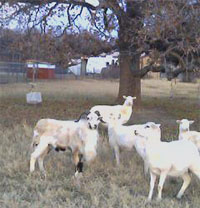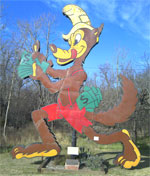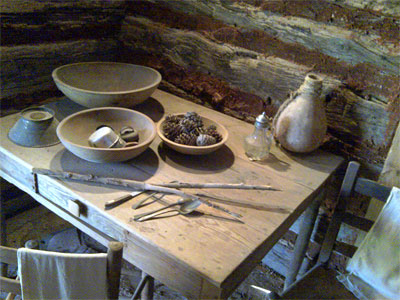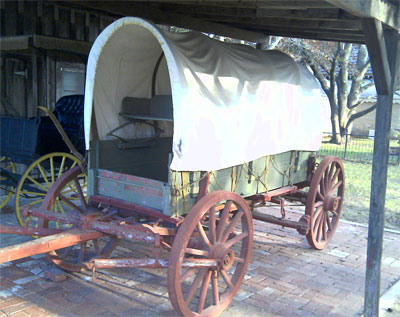Native Plant Road Trip to Stephenville
Pecan

Billy goat and nannies in Lipan, TX. All photos by Steven Chamblee.
I got up earlier than usual the other day, fed the critters, and hit the road while it was still dark. Headed down to Stephenville for my required pesticide applicator CEU’s. And even though I maintain Chandor Gardens almost “organically,” I’ll jump at any chance to stay current with the industry … and, hey, they generally serve a pretty good lunch at these things.
Gliding south on Hwy 281, I spend a good deal of time riding the shoulder, letting those panicked Tarleton State University students pass. I was once one myself, and remember well trying to make it down to TSU, find a parking spot, and get seated in time for that 8 a.m. class. Sunrise finds me just north of Lipan, right as I am passing a lovely green field dotted with those big, round hay bales. Picture perfect … I reach for my trusty camera … and discover I have left it at home. Now how am I going to take my e-gardens photos? Ugh. Eight minutes later, I’m taking pictures of a great-looking billy goat and his nannies with my cell phone. God bless technology!

Massive pecan soars skyward above the Bosque River.
The training was indeed excellent, and included a superb lecture on pecan production from Dr. Larry Stein, who started out his presentation with a lesson in proper pronunciation. “A ‘pah-cahn’ is a tree. A ‘pee-can’ is what my grandmother kept under the bed.” I learned a lot, like why they spray zinc on pecans (this essential element remains “locked up” in both high and low pH soils), why they thin pecan trees (full sun on each tree canopy produces more nuts than grown-together groves) and, most importantly, why it is so hard to make money growing pecans (work, work, work!). He spoke of the best pecan varieties for each section of Texas, which is important, since there are more than 500 cultivars of pecans, the first of which was developed in 1846. Thomas Jefferson gave pecans to George Washington, who planted them at Mount Vernon in 1786, where they are now the oldest living trees in the garden there. I also learned that those famous Jumbo Hollis pecans, while huge (33 to the pound, versus about 75 for normal pecans), are not particularly flavorful … so much for that whole “the bigger, the better” philosophy. And yes, the lunch was great.

The old Stephenville Church on the grounds of the Stephenville Museum.

The old Wolfe Nursery sign at the Stephenville Museum.
On the way home, I stop into the Stephenville Museum and get an excellent tour from office manager Kerri Fleming. After ringing the bell and checking out the historic Presbyterian Church (built 1899-1900) with its amazing curved pews, we head for the log cabins and … Holy Horticulture Detour! Behind the church, right there amid the bevy of bucolic buildings, is this giant, brightly painted steel sign of a cartoon wolf, complete with wads of cash in his paws. “Ummm … Kerri … what the Sam Hill is that?” Turns out that sign graced the front of the first Wolfe Nursery store, right here in Stephenville, for 45 years. The cash was a reference to the Wolfe motto, “Money DOES grow on trees!” Historic, interesting, but definitely out of place amid the worn wood buildings. I hope this sign will one day find a home where it can be appreciated by all.
Well, not far from that sign, right along the banks of the Bosque River, I spy a large, native pecan tree (Carya illinoinensis). Now this is what nature intended … a thick trunk erupting into an arching fountain of branches, forming an almost perfect 75-foot dome of beauty. Sure, the native nuts are smaller and harder-shelled, but they are arguably more flavorful, thus favored by cooks and connoisseurs. Sure, the tree always seems to be dropping something — catkins, twigs, leaves, nuts, husks — to the ground, but the tree provides a feast for creatures, people, and the soil in which it grows. The wood is quite lovely, and used for furniture, veneers, paneling, and artistic endeavors. The spent shells can be utilized as a nice garden mulch, or ground up and used in polishing metals and making non-skid paint. Pecans have been used by ancient cultures as far back as 6000 BCE in Texas, and literally saved both Spanish explorers and early pioneers from starvation. No wonder the pecan is the official State Tree of Texas.

Simple wares inside log cabin at Stephenville Museum.
Eventually, we get to the log cabins. There is something magical about log cabins … their minimalistic nature, their tight space, their hand-hewn logs. Oh, if these walls could speak. One cabin housed a couple and their 10 children in an area smaller than my living room. Another was the home of a secret concubine. Most were built by slaves, who left tool marks in the wood as testimony to their efforts. Tight dovetail corners (on logs, no less!), still snug after 150 years, tell the tale of careful, skilled carpenters who knew how to work the wood. A pillar wears a smooth area, polished by years of holding human hands. Upon reflection, these walls do indeed speak.

Unbelievable! A Studebaker wagon at the Stephenville Museum.

World’s largest cedar rocking chair at Natty Flats.
So I’m heading back to Weatherford (coincidentally, home of the Texas champion pecan tree) when I stop in at Natty Flats, a little group of shops on Hwy 281 just south of I-20 and home to that 25-foot rocking chair that must be seen to be believed. Inside the rustic exterior, the big store simply defines Texas country chic. They seem to specialize in big, beefy furniture expertly crafted of native Texas woods like oak, mesquite, bois d‘arc, pecan, and juniper. And while most of this stuff is out of my personal price range, it makes me feel good to walk among it, run my hands over the contours of the wood. An expert carpenter has cared enough to recognize the character of each piece of wood and honor it in each creation. Burls, twists, and knots, considered by industrial manufacturers as defects, here are revered and integrated into the furniture as accents and characteristics. You can actually still see the tree in the wood. It is still full of life and emotion; you can literally feel its strength, a kind of silent dignity under your fingertips. I find it so much more beautiful, so much more real than even the fanciest milled creations. Its organic nature resonates with something inside me, something primal and instinctive, and it makes me feel more alive.
Hmmm … I wonder what would happen if we viewed people the same way. If we viewed the burls, twists, and knots — passions, quirks, and imperfections — as traits to be treasured and revered, instead of defects to be discarded. I wonder if we worked with the wood, valuing its uniqueness and individuality, instead of trying to make all the wood straight-grained and uniform … I wonder if we’d end up with a utopian society in which you could actually still see its origins, literally feel its strength, and rejoice in its beauty.
When I think back over this year in retrospect, I am reminded of the beauty all around us. I usually take the small roads, and discover places that most folks miss; meet people who appreciate things like handmade quilts, fresh eggs, and a little patch of wildflowers. I have learned to revere some of the simple things in life, like the warm smiles and kind words that always fill the hall of the Bright Arboretum in Woodway … the hundreds of vases of native wildflowers at the April festival in Brownwood … the charm of a petrified wood gas station in Decatur … a birthday cake in Rosenberg … and a sweet, droopy-eared dog in Tomball.
Come to think of it, we do live in that utopian society … and it’s called Texas.
Peace & Love,
Steven
About the author: Steven Chamblee is the chief horticulturist for Chandor Gardens in Weatherford and a regular contributor to Neil Sperry’s GARDENS magazine and e-gardens newsletter. Steven adds these invitations:
While Chandor Gardens is officially closed during the winter months, lots of visitors still enjoy the garden during "the bones season." Just give us a call before you come out to make sure we’re here: 817-613-1700 or 817-598-4029.
A little help from my friends…. I still need some destinations for my Texas road trips! If you would like me to speak to your garden club or group, just shoot me an e-mail at schamblee@weatherfordtx.gov to make arrangements. I’m inexpensive and low maintenance, and you know I love to go just about anywhere, so let me know. No city too big; no town too small. As long as it has a Farm to Market road nearby, I’m in.

